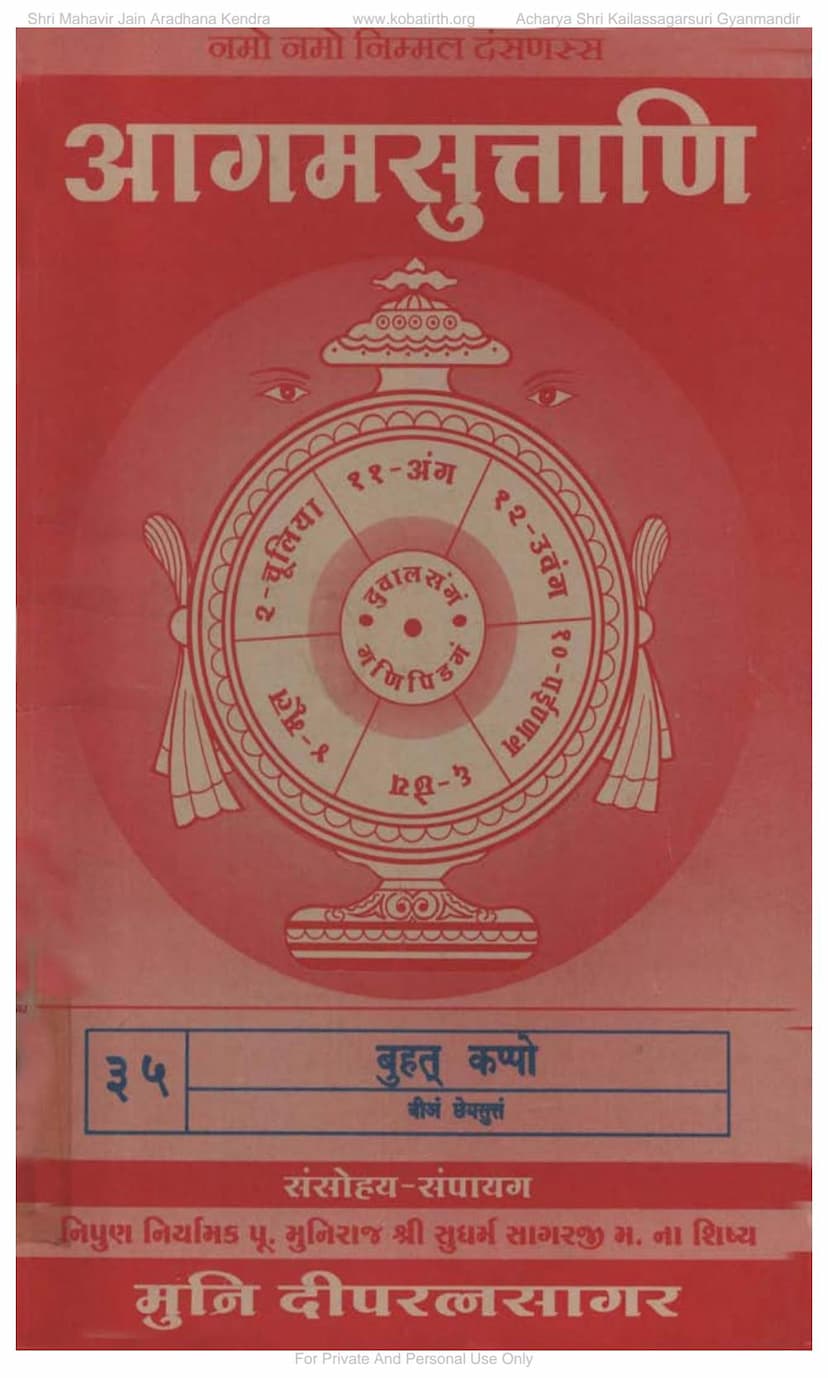Agam 35 BuhatKappo Chheysutt 02 Moolam
Added to library: September 1, 2025
Loading image...

Summary
This document is a Jain religious text titled "Agam 35 BuhatKappo Chheysutt 02 Moolam," authored by Dipratnasagar and Deepratnasagar, and published by Agam Shrut Prakashan. It is presented as a part of a larger collection of Jain Agam Sutras.
The text appears to be a scholarly or devotional compilation, as indicated by the introductory pages which include:
- Acknowledgements and Dedications: Several pages are dedicated to acknowledging financial donors and individuals who contributed to the publication. This highlights the community support for preserving and disseminating these sacred texts.
- Publication Details: Information about the publisher, printing press, and compositors is provided.
- Catalog and Library Information: The text mentions "Shri Mahavir Jain Aradhana Kendra" and "Acharya Shri Kailassagarsuri Gyanmandir," indicating its origin from specific Jain institutions or libraries.
- Index and Structure: A significant portion of the document (Pages 6 onwards) details the structure of the text, including chapters (Uddesos) and verses (Sutras). It outlines an index of contents, including various appendices and indices like "Parisishṭa-Nidarshanam" (Index of Contents), "Visiddha Saddāṇukramo" (Specific Word Index), "Visheṣa Nāṁnānukramo" (Index of Special Names), and "Gāthāṇukkamo" (Index of Verses).
- The Sutra Text: The core of the document, starting from page 7, contains the actual Jain sutras in Prakrit or a related ancient Indian language, along with numbering systems. These sutras appear to be regulatory or ethical guidelines for Jain ascetics (monks and nuns) regarding their conduct, practices, and interactions with the world. The content spans various topics:
- Rules concerning food and its reception (pages 7-10).
- Guidelines for dwelling places and their usage (pages 8-10).
- Rules related to clothing and personal belongings (pages 8, 11-12).
- Prohibitions and permissions for various actions, including speech, movement, and daily activities (pages 8, 11-15).
- Specific injunctions for ascetics during different seasons or circumstances (pages 8, 10, 12-15).
- Detailed rules about interactions with lay followers (pages 10, 12-14).
- Disciplinary measures and transgressions (pages 13-16).
- Rules concerning community living and organizational matters (pages 15-16).
- Guidelines for monks and nuns joining different monastic groups or seeking guidance (pages 15-16).
- Rules related to illness and health (pages 16-17).
- Specific conduct during times of crisis or natural phenomena (pages 17-18).
- Prohibitions related to inappropriate speech or behavior (pages 19-20).
- Rules concerning spiritual practices and moral conduct (pages 19-20).
- Guidelines for handling offerings and donations (pages 19-20).
- Rules about seeking and providing assistance (pages 19-20).
- Regulations on movement and residence (pages 19-20).
- Specific prohibitions for nuns regarding solitude and public exposure (pages 19-20).
- Detailed rules about permissible and impermissible postures and activities for nuns (pages 20-21).
- Guidelines on receiving alms and food (pages 19-21).
- Rules about the proper use of alms bowls and other monastic requisites (pages 19-21).
- Regulations on the conduct of ascetics in various situations, including interactions with celestial beings or experiencing afflictions (pages 18, 20-21).
- Rules concerning monastic duties and responsibilities (pages 21-22).
- Instructions on renouncing a monastic order and joining another (pages 15-16).
- Rules related to ascetic practices, such as fasting, vows, and penances (pages 16, 21).
- Guidelines for spiritual teachers and their disciples (pages 15-16, 21-22).
In essence, "Agam 35 BuhatKappo Chheysutt 02 Moolam" is a foundational text within Jainism, likely detailing the "Kappas" or rules and regulations for the conduct and discipline of Jain monks and nuns. It provides explicit instructions on how to live an ascetic life in accordance with Jain principles.